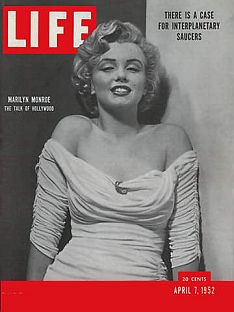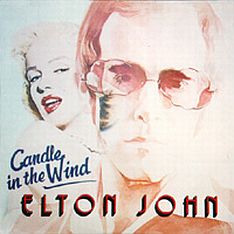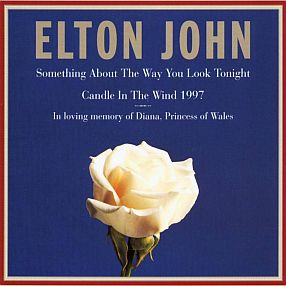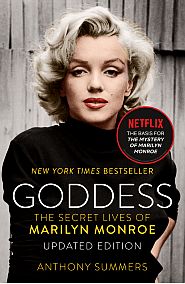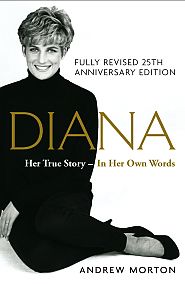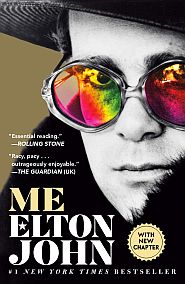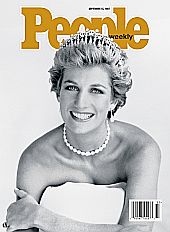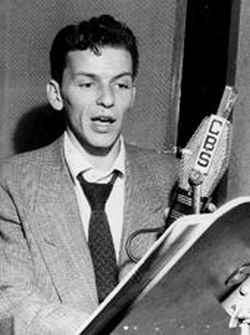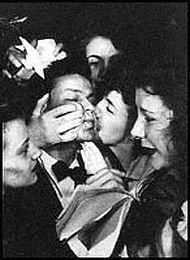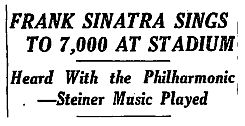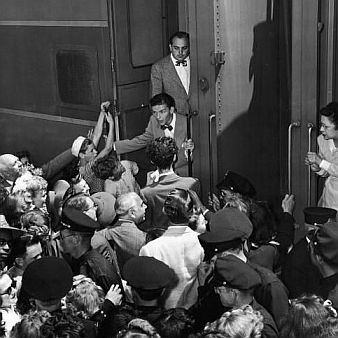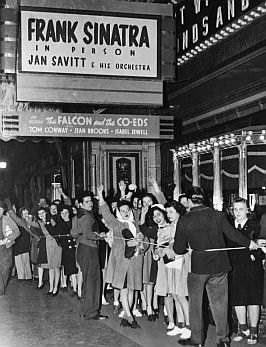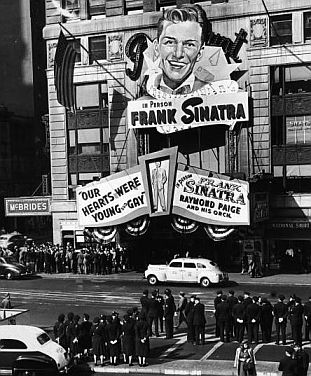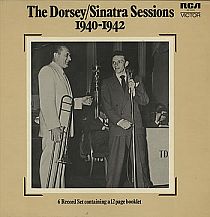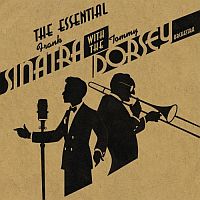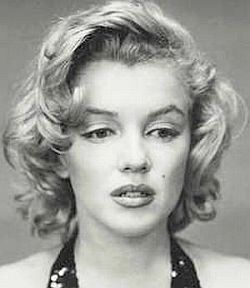
Marilyn Monroe in a troubled, far-away moment, captured by Richard Avedon, NY, May 1957. Click for related Marilyn photo books at Amazon.com.
The song was originally written as a tribute to Hollywood movie star Marilyn Monroe who died at the age of 36 in August 1962.
Taupin had been inspired by the phrase “candle in the wind” when he heard someone use it to describe Janis Joplin, the blues-rock singer who died of a heroin overdose in 1970.
In Monroe’s case, too, the phrase was especially appropriate, given her tumultuous life and untimely death. The song’s opening line, “Goodbye Norma Jean” refers Monroe’s real first name, and the lyrics chronicle her troubled life as a film star and international celebrity.
John and Taupin’s “Candle in the Wind” aptly captures some of the tragedy and mystique that was Marilyn Monroe, and the long-standing public fascination with her life.
But as Taupin would later remark, the song is about “the idea of fame or youth or somebody being cut short in the prime of their life. The song could have been about James Dean, it could have been about Montgomery Clift, it could have been about Jim Morrison ….how we glamorize death, how we immortalize people.”
“Candle in the Wind” was first released on Elton John’s 1973 album Goodbye Yellow Brick Road and also appeared on later albums. A single version of the song reached No. 11 on the U.K. charts in 1974. It wasn’t released as a single in the U.S. until 1987, when a live version from Elton’s Live In Australia album charted.Music Player
“Candle in The Wind”
In 1990, the song rose to prominence again when John rededicated it to AIDS victim Ryan White, performing it in his honor at the Farm Aid 4 concert and at White’s funeral. But in 1997, following the death of Princess Diana, John did a remake of “Candle in the Wind” as a tribute to Diana, a personal friend. This version of the song, with new lyrics, was released as a single and sold wildly throughout the world, peaking at number one in almost every country where it was sold. That part of the story continues below the lyrics and photographs that follow.
|
“Candle in the Wind” |
| Goodbye Norma Jean Though I never knew you at all You had the grace to hold yourself While those around you crawled They crawled out of the woodwork And they whispered into your brain They set you on the treadmill And they made you change your name |
| And it seems to me you lived your life Like a candle in the wind Never knowing who to cling to When the rain set in And I would have liked to have known you But I was just a kid Your candle burned out long before Your legend ever did |
| Loneliness was tough The toughest role you ever played Hollywood created a superstar And pain was the price you paid Even when you died Oh the press still hounded you All the papers had to say Was that Marilyn was found in the nude |
| Goodbye Norma Jean From the young man in the 22nd row Who sees you as something more than sexual More than just our Marilyn Monroe |
Princess Diana Version
After Princess Diana was killed in a car crash in Paris, France on August 31, 1997, Elton John, who had been a very close friend of Diana’s and the Royal Family, went into a period of shock and mourning. Only a month prior to Diana’s death, John had been rocked by the passing of another friend, Italian designer Gianni Versace, a funeral which he and Diana attended in Milan on July 22nd.
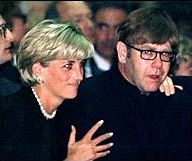
Princess Diana & John at Gianni Versace's funeral, July 1997.
Elton John and Princess Diana had been friends since 1981. He had performed at Prince Andrew’s 21st birthday party at Windsor Castle and received a thank-you letter from 19-year-old Diana Spencer, then engaged to Prince Charles. Prior to his friendship with Diana, John had been a friend of the Royal Family since the late 1970s. He had accompanied Princess Margaret to arts events, participated in Prince Charles’s annual concerts for youth charities, and had been a frequent performer at private royal events. He was also a friend of Sarah Ferguson, and he and former wife Renate were seated in the front row for the wedding of Ferguson and Prince Andrew. At Diana’s death, John was asked by the family to sing at Diana’s funeral and decided to write a tribute for his former friend. After meeting with his writing partner, Bernie Taupin, they found it would not be possible to write a new song in the time available and decided instead to rewrite the former 1973 “Candle in The Wind” song with new lyrics for Diana. George Martin, the music producer who had long been affiliated with Beatles, was also contacted to help produce the song. In production, a string quartet and woodwinds were added to the recording. This version was titled “Candle in the Wind 1997,” and was later released as a single with two other songs “Something About The Way You Look Tonight” and “You Can Make History (Young Again).”
|
“Candle in the Wind” |
| Goodbye England’s Rose May you ever grow in our hearts. You were the grace that placed itself Where lives were torn apart. You called out to our country, And you whispered to those in pain. Now you belong to heaven, And the stars spell out your name. |
| And it seems to me you lived your life Like a candle in the wind: Never fading with the sunset When the rain set in. And your footsteps will always fall here, Along England’s greenest hills; Your candle’s burned out long before Your legend ever will. |
| Loveliness we’ve lost; These empty days without your smile. This torch we’ll always carry For our nation’s golden child. And even though we try, The truth brings us to tears; All our words cannot express The joy you brought us through the years. |
| Goodbye England’s Rose, From a country lost without your soul, Who’ll miss the wings of your compassion More than you’ll ever know. |
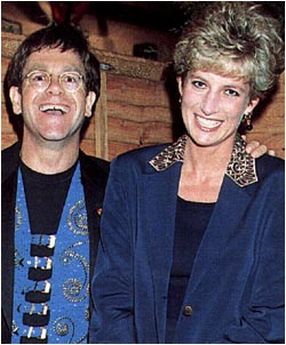
Elton John & Princess Diana in happier times.
Giant Best-Seller
“Candle in the Wind 1997” carried the label of Elton John’s Rocket Records and was distributed by Hollywood-based A&M Records, a unit of PolyGram. Before the CD shipped, there were reportedly orders for more than 12 million copies in the U. S. alone. By late September 1997, the song took the American pop charts by storm, entering the Billboard Hot 100 at No. 1, smashing the existing record for first-week sales with nearly 3.5 million copies sold over six days from its September 22nd release.At its peak worldwide, the Diana version of “Candle in the Wind” was selling at an estimated rate of nearly six copies per second. The previous first-week sales record of 632,000 had been set in late December 1992 by Whitney Houston’s “I Will Always Love You.” All in all, “Candle in the Wind 1997” sold over 11 million copies in the U.S. In the U.K. sales also soared. In its first week the song sold 658,000 in one day, and over 1.5 million copies for the first week. The single would remain at No. 1 in the U.K. for five weeks and eventually sold 4.86 million copies there, becoming the best-selling single of all time in the UK. In Canada, it spent 45 weeks at the top spot and three years in the top 20. Worldwide, it is estimated that the single sold more than 35 million copies. At the peak of its sales, worldwide, it was estimated that nearly six copies were sold every second.
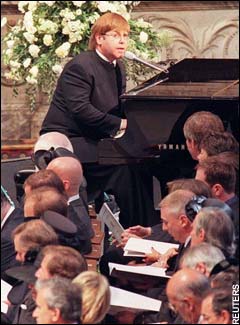 John performing 'Candle' at Diana’s funeral. |
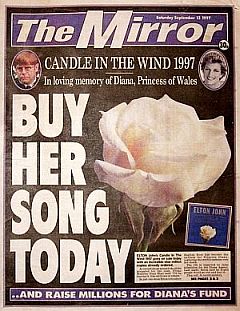 "The Mirror" newspaper of Sept 13, 1997 giving a boost to "Candle 1997." |
As of 2006, “Candle in the Wind, 1997” was ranked as the world’s best-selling CD single in history. Bing Crosby’s “White Christmas” was still ranked as the world’s best selling vinyl single.
All artist and composer royalties and record company profits from “Candle in the Wind 1997” were donated to “The Diana, Princess of Wales Memorial Fund.” Many music store retailers, however, did profit on their share of the song’s sales.
Elton John sang “Candle In The Wind 1997” in public, for the first and only time at Diana’s funeral in Westminster Abbey on September 6th, 1997.
John has repeatedly turned down requests to perform the song live and it has never been released on any of his albums. However, he has stated he will perform the song again if requested by Diana’s sons, which to date has not occurred. At concerts, John performs the original 1973 version.
Memorial Fund
By September 1999, income to “The Diana, Princess of Wales Memorial Fund” was estimated at $150 million, much of it from royalties generated by sales of “Candle in the Wind 1997.”
Since then the Fund has continued to further humanitarian causes advocated by Diana with its grants, also helping improve the lives of disadvantaged people in the UK and around the world with grants and other assistance. It has also championed additional causes by lending the Fund’s name to other important efforts. More information on the Fund can be found below in “Sources, Links & Additional Information.”
For more detail on the career of Elton John, see “Elton John’s Decade: 1970s (w/Bernie)”. For more on the life & loves of Marilyn Monroe, see “Marilyn & Joe, et al,” which also covers the media fascination with her over 70 years. Additional stories on contemporary music, profiles of artists and song histories, can be found at the “Annals of Music” category page. Thanks for visiting – and if you like what you find here please make a donation to help support the research and writing at this website. Thank you. – Jack Doyle
|
Please Support Thank You |
______________________________
Date Posted: 26 April 2008
Last Update: 23 July 2023
Comments to: jackdoyle47@gmail.com
Twitter: https://twitter.com/PopHistoryDig
Article Citation:
Jack Doyle, “Candle in the Wind, 1973 & 1997,”
PopHistoryDig.com, April 26, 2008.
_____________________________
Books at Amazon.com…
Sources, Links & Additional Information
“Candle in the Wind” and “Elton John,” Wikipedia.org.
Richard Harrington, “Elton John: Diana’s Song,” Washington Post, Friday, September 5, 1997; Page D-2.
Bill Carter, “Elton John’s Revised ‘Candle,’ For a Princess and Charity,” New York Times, September 9, 1997.
Reuter, “Elton John’s Diana Tribute Ignites U.S. Charts,” October 1, 1997.
Jon Pareles, “October 19-25; Roll Over, Bing Crosby,” New York Times, October 26, 1997.
Warren Hoge, “London Journal; Two Years On, Diana Is the ‘Forgotten’ Princess,” New York Times, September 1, 1999.
“Candle in the Wind 1997,” Wikipedia.org
The Diana, Princess of Wales Memorial Fund.
_______________________________________________

